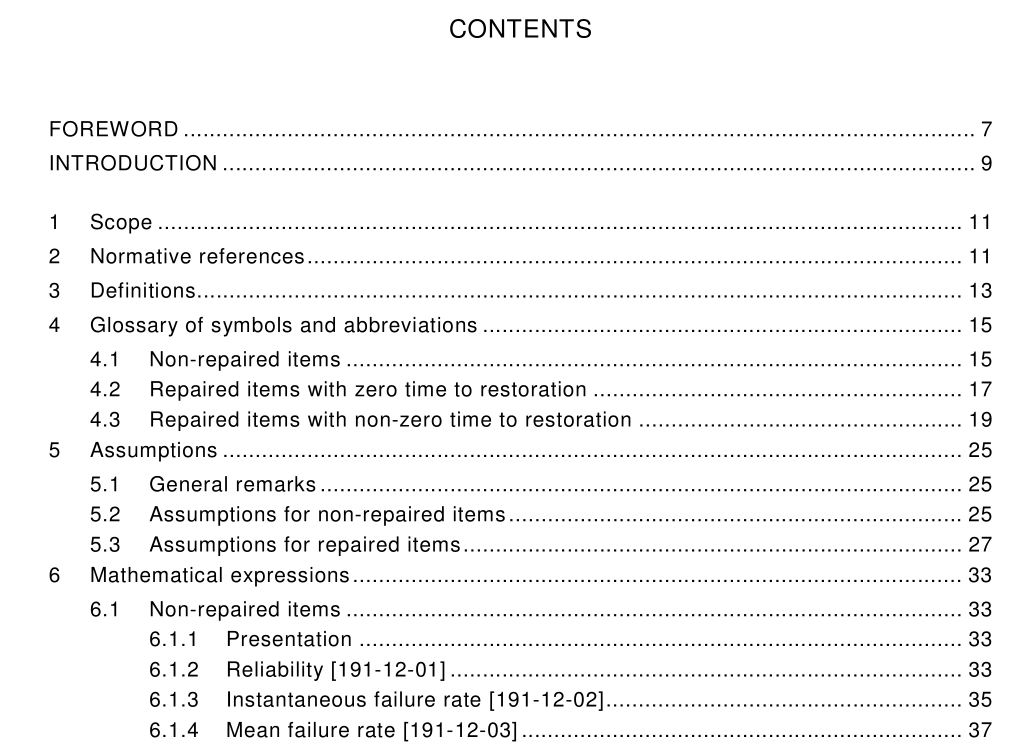IEC 61703 pdf download

IEC 61703 pdf download.Mathematical expressions for reliability, availability, maintainability and maintenance support terms
1 Scope
This International Standard provides mathematical expressions for reliability, availability, maintainability and maintenance support measures defined in IEC 60050-1 91 . The following classes of items are considered separately in this standard: – non-repaired items; – repaired items with zero time to restoration; – repaired items with non-zero time to restoration. In order to keep the mathematical formulae as simple as possible, the following basic mathematical models are used to quantify dependability measures: – random variable (time to failure) for non-repaired items; – simple (ordinary) renewal process for repaired items with zero time to restoration; – simple (ordinary) alternating renewal process for repaired items with non-zero time to restoration. To facilitate location of the full definition, the IEC 60050-1 91 reference for each term is shown (in parenthesis) immediately following each term, for example: mean time to restoration [1 91 -1 3-08] The application of each dependability measure is illustrated by means of a simple example. NOTE This standard is mainly applicable to hardware dependability, but many terms and their definitions may be applied to items containing software. Some of the software dependability aspects are explained in annex D.
2 Normative references
The following normative documents contain provisions which, through reference in this text, constitute provisions of this International Standard. For dated references, subsequent amendments to, or revisions of, any of these publications do not apply. However, parties to agreements based on this International Standard are encouraged to investigate the possibility of applying the most recent editions of the normative documents indicated below. For undated references, the latest edition of the normative document referred to applies. Members of IEC and ISO maintain registers of currently valid International Standards.
5 Assumptions
5.1 General remarks In order to derive correct mathematical expressions for the measures defined in IEC 60050-1 91 , the distinction needs to be made between repaired items [1 91 -01 -02] and non-repaired items [1 91 -01 -03]. The following classes of items are considered separately in this standard: – non-repaired items; – repaired items with zero time to restoration; – repaired items with non-zero time to restoration. In order to keep the mathematical formulae as simple as possible, the following basic mathematical models are used to quantify dependability measures: – random variable (time to failure) for non-repaired items; – simple (ordinary) renewal process for repaired items with zero time to restoration; – simple (ordinary) alternating renewal process for repaired items with non-zero time to restoration. The simplest mathematical model for the reliability of a non-repaired item is a random variable – the time to failure of the item [1 91 -1 0-02]. One of the widely used reliability measures of non-repaired items is the instantaneous failure rate λ (t) [1 91 -1 2-02], also referred to as the hazard rate function. It is derived from the distribution function of the time to failure. The expression λ (t)∆t is the conditional probability of failure of an item during the time interval (t, t + ∆t) given that the item has not failed during the interval (0, t). For repaired items, the basic model is a simple renewal process, when the time to restoration of the item may be neglected, or a simple alternating renewal process when the time to restoration of the item is non-zero. In the latter case, the item alternates between an up state and a down state, and a widely used measure of reliability of the item is the failure intensity, which is equal to the renewal density. The failure intensity [1 91 -1 2-04] is a measure derived from the expected value of the cumulative number of failures E[N(t)] of a repaired item occurring during the time interval (0, t).









